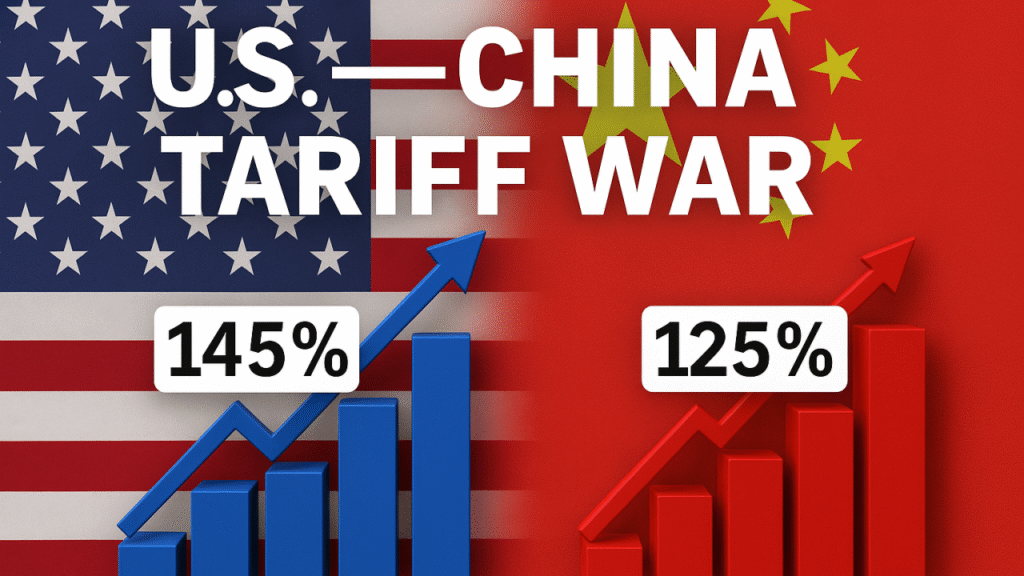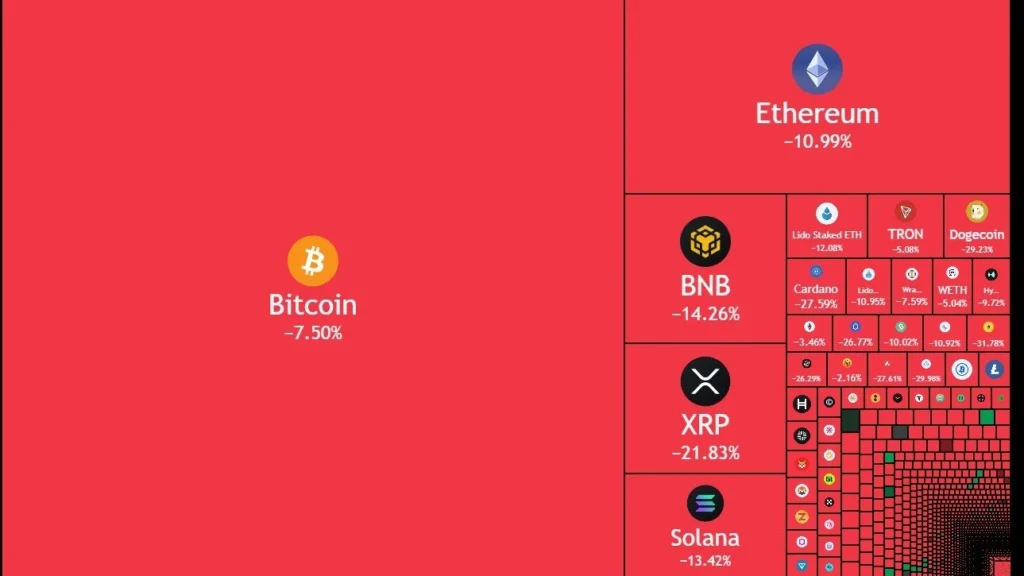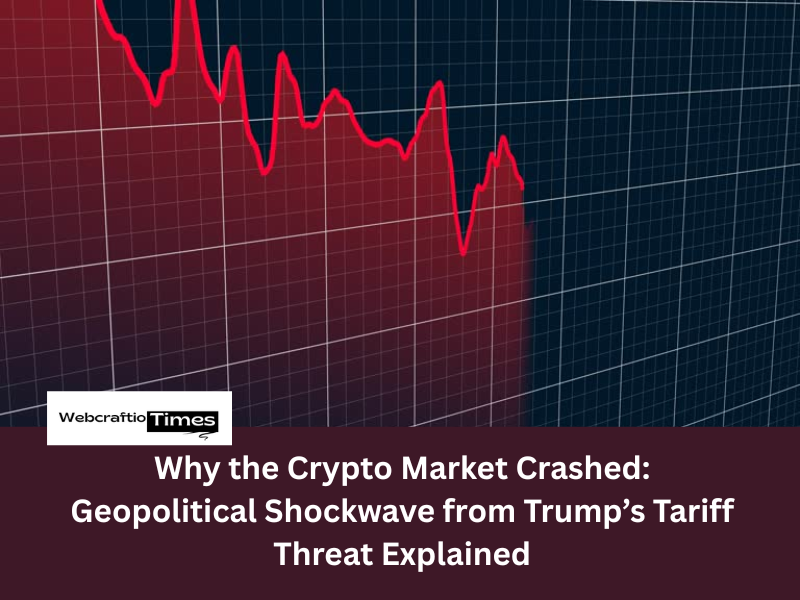The cryptocurrency market, often touted as a decentralized financial system immune to traditional politics, was recently blindsided by a single social media post from former U.S. President Donald Trump. In what analysts are calling the “largest liquidation event in crypto history,” a swift, cascading sell-off wiped out billions of dollars in leveraged positions, underscoring the market’s deep sensitivity to global geopolitical tensions and macroeconomic policy shifts.
This in-depth analysis will dissect the cause, detail the devastating market impact on top coins, and explore the long-term implications for investors navigating the volatile intersection of digital assets and international trade wars.
The Catalyst: A 100% Tariff Threat
The dramatic crash was not caused by a flaw in blockchain technology, an exchange hack, or a major regulatory crackdown from a stable government. Instead, the trigger was a renewed escalation of the U.S.-China trade war.
The sequence of events began when China escalated tensions by announcing new, stringent export controls on rare earth minerals, critical materials essential for the global tech supply chain, including semiconductors and advanced components vital for the crypto mining industry.
In a fiery response posted on his social media platform, President Trump announced a plan to impose a 100% tariff on all Chinese imports and new export controls on “any and all critical software,” with the measure set to take effect on November 1, 2025.

This single announcement, a stark threat to global trade stability, sent immediate shockwaves through all financial markets, with the highly leveraged and 24/7 crypto market bearing the brunt of the initial panic
The Fall of Market: The Scale of the Crash
The reaction in the crypto space was immediate and brutal. Investors, fearing a global economic slowdown and a severe disruption to supply chains, rushed to exit risky positions, especially those using high leverage.
You May Like This : Snapchat’s New Paid Storage: The Cost of Saving Your Memories
Record-Breaking Liquidations
Data from leading analytics firms like CoinGlass confirmed the historic scale of the panic.
- Total Liquidations:
Reports indicate that over $19 billion in leveraged crypto positions were liquidated in a single 24-hour period, with some estimates pushing the total well over $30 billion once all exchanges and decentralized finance (DeFi) platforms are accounted for.
- Speed of the Sell-off:
Crucially, over $7 billion of these positions were liquidated in less than one hour, demonstrating a flash-crash dynamic amplified by automated trading and thin liquidity during non-traditional trading hours.
- Affected Traders:
More than 1.6 million traders saw their positions forcibly closed, with the vast majority being long positions, bets on rising prices, which cascaded into a vicious liquidation spiral.
How Top Coins Crashed
The sell-off was indiscriminate, hitting the top digital assets with force, completely reversing recent bullish momentum that had seen Bitcoin flirt with new all-time highs.
| Cryptocurrency | Approximate Decline in 24 Hours | Low Price Tested |
| Bitcoin (BTC) | 7.6% – 12% | Briefly fell to $103,000 |
| Ethereum (ETH) | 11.2% – 14% | Fell to roughly $3,742 |
| Solana (SOL) | ~20% | Fell to approximately $178 |
| XRP | ~22.85% | Experienced one of the steepest drops |

The high volatility of the crypto market meant that even a relatively moderate decline in Bitcoin’s price was enough to trigger massive liquidations for highly leveraged traders. Ethereum, which often experiences greater volatility than Bitcoin, saw an even steeper percentage drop. Altcoins like Solana and XRP, however, suffered the most punishing losses, highlighting the increased risk associated with assets lower down the market capitalization ranks during periods of extreme global risk aversion.
Spread and Leverage
To understand why a trade war threat caused such a seismic event in the crypto market, one must look at the role of leverage and the mechanical nature of liquidation.
The Leverage Trap
Cryptocurrency exchanges offer high-leverage trading (up to 100x or more), allowing traders to control a large position with a small amount of capital. While profitable on the way up, this practice is a double-edged sword: a small market move against the trade can quickly wipe out the entire collateral.
You May Read This : Pixel October 2025 Update Fixes Display Nightmares: Here’s What’s Really Going On
When Trump’s tariff announcement injected macro-panic into the market. Even a modest initial price dip was enough to force the liquidation of the most over-leveraged “long” positions. This forced selling further drove down the price, triggering the liquidation of the next wave of leveraged trades, creating a cascading liquidation event that fueled the historic crash. This phenomenon is a stark reminder of crypto’s high-beta status. It tends to amplify the movements seen in traditional financial markets.
The Insider Trading Allegations
The extreme timing of the sell-off led to fresh claims of potential insider trading. Reports surfaced that a massive short position (a bet on prices falling) was placed on Bitcoin and Ethereum. Just half an hour before President Trump made his public announcement.

This highly suspicious timing prompted calls for investigation from political figures and market observers. Raising questions about whether someone with advanced knowledge profited from the global trade scare.
Broader Implications and The Road Ahead
This event solidifies the crypto market’s evolution from an isolated niche to a genuinely integrated global asset class. Bitcoin is now reacting to global trade policy, inflation data, and central bank signals, a sign of maturity, albeit one that comes with new vulnerabilities.
A Test of Resilience
Despite the nearly trillion-dollar market value wiped out in less than 24 hours (including the subsequent decline), the crypto market quickly showed signs of a partial recovery after President Trump softened his rhetoric over the weekend, hinting that “it will all be fine” between the U.S. and China.
For long-term investors, market analysts are viewing this severe correction as a necessary “leveraged reset”. A painful but ultimately healthy purge of excessive speculative leverage from the system. Market experts suggest that such dips can create attractive entry opportunities for patient investors focused on fundamentally strong assets like Bitcoin and Ethereum.
Advice for Crypto Investors
- Macro Matters: Investors must recognize that crypto prices are no longer purely driven by “crypto news.” Geopolitical events, trade wars, and U.S. policy decisions have a direct and powerful impact.
- Beware of Leverage: The speed and scale of the liquidation event serve as a severe warning against over-leveraging. Trading with high leverage amplifies risk to unsustainable levels during macro shocks.
- Liquidity is Key: The crash highlights the importance of liquidity, especially in a 24/7 market. Thin liquidity can exacerbate price swings and accelerate cascading liquidations.
The Trump tariff 19$ Billion Crypto Crash of October 2025 will be remembered not just for the billions lost. But as a defining moment that fully cemented digital assets as high-risk, high-reward macro assets fundamentally intertwined with the stability of the global economy.
FAQs about the recent crypto market crash:
Q1: What specifically caused the recent major crypto market crash?
A: The crash was primarily triggered by President Donald Trump’s announcement of a plan to impose a 100% tariff on Chinese imports and new export controls on critical software, escalating fears of a global trade war.
Q2: How much money was liquidated during this event?
A: Data reports show that over $19 billion in leveraged crypto positions were liquidated in a single 24-hour period. Making it widely described as the largest single-day liquidation event in crypto history.
Q3: How much did major cryptocurrencies like Bitcoin and Ethereum drop?
A: In the immediate aftermath, Bitcoin (BTC) plunged by roughly 8% to 12%, testing lows near $103,000. Ethereum (ETH) saw an even steeper decline, dropping by about 11% to 14%.
Q4: Why did this political news affect the crypto market so severely?
A: The crypto market, particularly leveraged trading, is highly sensitive to geopolitical and macroeconomic risks. The tariff news sparked panic selling. Which led to a cascading liquidation of highly leveraged trading positions, amplifying the price drop.
Q5: Did this event only affect the cryptocurrency market?
A: No. The tariff threat also caused a significant sell-off in traditional financial markets. The S&P 500 Index and the tech-heavy Nasdaq also recording sharp declines due to renewed trade war concerns.



